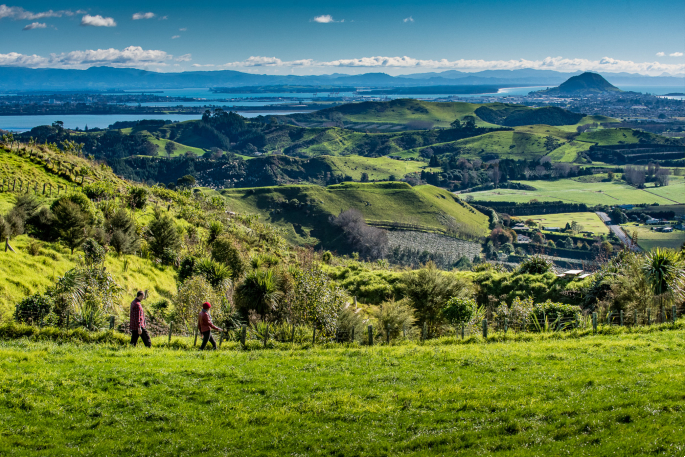Changes to how much open space people will have access to as Tauranga grows is under the spotlight.
Tauranga City Council is proposing to change the requirements for the proximity, amount of space and the type of parks and reserves that people can access from their homes in new developments.
This comes as the council prepares to develop land in Tauriko West and Te Tumu in Pāpāmoa East for housing.
The Open Space Level of Service Policy currently has a standard requiring of 1.7 ha per 1000 people of neighbourhood and local reserves for new greenfield developments, with at least 50 per cent of that neighbourhood reserves.
Council proposed to amend the standard to no longer require 50 per cent to be neighbourhood reserve, provided neighbourhood reserves would be within 400m of most residences.
A neighbourhood reserve was around 3000m2, had a play area and flat open space within 400m of homes, according to council's consultation document.
While a local reserve was an area for informal activities, with pathways for walking and cycling around ¬3000m2 in size within 2km of homes.
Consultation on the proposed changes ran from September 12 to 30 and 14 submissions were received.
Public hearings were held at a Strategy, Finance and Risk Committee meeting on Monday.
Envirohub chair Mary Dillon told the meeting she was open to the policy being 'more flexible” and there was a need to look at greenspaces differently to fit in with future growth and the changing population.
'People have to be connected to nature in a very personal way. It's a doorway to getting people's support in terms of climate change action,” said Dillon
 Envirohub chair Mary Dillon. File photo/SunLive.
Envirohub chair Mary Dillon. File photo/SunLive.
The former Tauranga deputy mayor and councillor said it was 'important” the developers and council 'sat down at the beginning and worked through” the plans to include open space and stormwater reserves in the design.
In response commissioner Shardrach Rolleston said: 'I support wholeheartedly us thinking about the way we plan and the way we deliver those services right from the outset.”
Jeff Fletcher presented on behalf of the Ford Land Holdings group and Tumu Kaituna 14 Trust that represents two of the three main land owners in Te Tumu.
He said the land was 'looking to be rezoned somewhere in the near future” and the policy was 'really important” in regard to that.
Half of the 760 hectares of land was protected and would remain protected after rezoning, said Fletcher.
The land was bounded by the coastal strip on one side and the protected zone comprised of areas of biodiversity, natural character, cultural significance and, archaeological sites.
'In general, the landowners' broadly support, the approach that's been taken here, it does provide for a greater and more pragmatic approach to the provision for neighbourhood reserves.
'Analysis done by the council team several years ago, showed effectively a chicken pox view of neighbourhood reserves across the growth areas, as opposed to more strategic and pragmatic alignment of neighbourhood reserves.”
The landowners wanted the flexibility to work with the council and stakeholders to develop a 'range of neighbourhood reserve experiences”, said Fletcher.
Commission chair Anne Tolley responded: 'Flexibility and making sure that we have something for everyone in a neighbourhood is certainly where we're trying to end up.”
Chief executive of land development company Bluehaven Group Nathan York called for the whole policy to been reviewed.
'I understand that the new urban growth areas have an overlay around quality [of open spaces] as opposed to the quantity metric.
'What we don't see is the same metric being applied in existing consented development areas.”
He said it was 'hard” for the company to meet the current policy requirements especially if the council wanted intensification.
York also wanted 'clarification” on how the council would 'measure quality” as this was 'important for developers going forward”.
'We want to see quality because quality generally translates into more people using the reserve space.”
.jpg) Commission chair Anne Tolley. Photo: John Borren/SunLive.
Commission chair Anne Tolley. Photo: John Borren/SunLive.
Tolley replied the policy was 'looking to get equity across the city with access to green space and reserve space, but sometimes it's not as easy as it seems.
She said York's point about quality was 'absolutely right”.
'One of the things I would certainly be looking for from a policy would be that it caters for a mixture of recreational activities, whether those are active or passive, that goes across all age ranges, that's accessible.”
Commissioner Stephen Selwood said the 'key message” they heard from the submitters was to understand the 'overall context” of a development and 'match it with the reserve policy … rather than being prescriptive”.
The committee will deliberate on the issues raised by submitters on December 5.
Public Interest Journalism funded through NZ On Air




1 comment
how about...
Posted on 21-11-2022 15:14 | By hexsayer
just leaving the land alone.... so youre going to start developing an old battleground and burial site and digging up literal bones just so you can sell some houses to foriengers. No thanks, you deserve all the badluck coming your way if you take any part in whats happening in Te Tumu.
Leave a Comment
You must be logged in to make a comment.